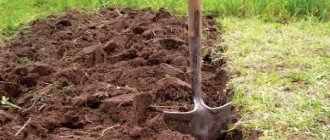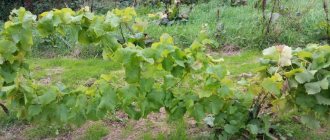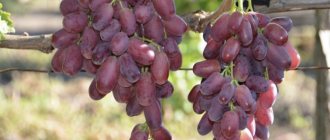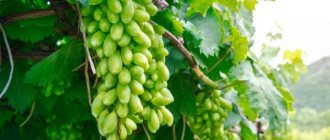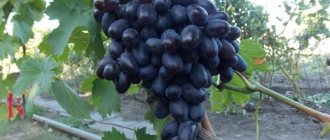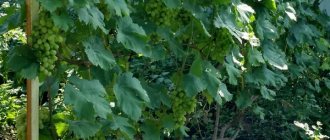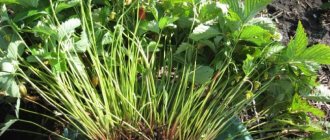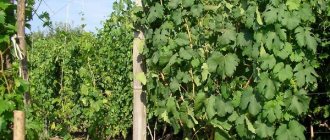Origin
The grape is a natural hybrid that resulted from the pollination of European noble grapes with pollen from the native American Vitis Labrusca.
The discovery of the new variety belongs to the breeder William Prince, who discovered it in 1816 on the lands of George Gibbs. The name of the new variety was allegedly given by the name of the landowner's wife.
During the spread of Isabella in America, and later in Europe, winegrowers noted its unpretentiousness, cold resistance and high yield.
The characteristic taste found both supporters and opponents, but Isabella gained a strong position in the second half of the 19th century thanks to its resistance to the original American pest - phylloxera, which destroyed entire hectares of vineyards in Europe.
At the end of the 20th century, Isabella was banned from growing for wine in the European Union and the United States, allegedly due to the presence of methyl alcohol and a “foxy” taste. Later, the health data was not confirmed, but the popularity of grapes decreased significantly.
Planting and care
Traces of the North American species Vitis Labruska and its native habitat have influenced the cultivation of Isabella grapes.
It is not so thermophilic due to the fact that the ancestor grows in more northern regions compared to the Mediterranean Vitis Vinifera. It also needs more moisture. Therefore, Isabella is less demanding about the dryness of the area. At the same time, it allows cultivation on moister soils.
However, no one has canceled the combination of active temperatures, so if you want to get a ripe harvest by autumn, you should locate the future vineyard in a sunny area.
One of the main care requirements is pinching and trimming shoots.
Climate and region of growth
In Russia, Isabella is grown in the southern latitudes - Krasnodar and Stavropol Territories, in Dagestan. Large areas of vineyards of this variety have traditionally been in Crimea.
The variety's winter hardiness and tolerance to humid climates allows it to be effectively grown in the Volga region. Among Russia's closest neighbors, Isabella continues to be cultivated in Moldova, Georgia, and Azerbaijan.
Wines from this variety are also loved in South America, in particular in Brazil. In Europe and the USA, Isabella can be found only among a few enthusiasts.
The soil
Isabella is undemanding to soil and grows excellently without problems on most types of steppe and forest-steppe soils. Poor soil composition is not a hindrance if the required doses of fertilizers are applied in a timely manner.
The grapes are very unpretentious, grow well, but have their own characteristics, which we will discuss below.
Characteristics of the variety
Isabella has an average cluster size, weighing up to 150 grams. The bushes are tall. The berries can be large or medium, have a dark blue or purple color and are covered with a waxy coating. Their taste is sweet and sour, juicy with a characteristic strawberry flavor and aroma. The skin is dense, the flesh is fleshy. The berries can be consumed fresh, and can also be used to make wines, juices, and compotes. Productivity is high. The ripening period is up to 180 days from the moment the buds open. This is a late variety and can only be harvested at the end of September. In addition, it is often grown as an ornamental plant for landscaping gardens, as it looks very beautiful.
Isabella's bunches weigh an average of 150 grams
Features of cultivation
Like any plant, grapes have their own cycles and subtleties. Next, we will tell you the secrets of cultivation, which were collected from the combined experience of winegrowers in the CIS countries.
Planting and Harvest Time
Due to the high growth rate of the bush, cuttings are planted in the spring. During the first year, the chibouk takes root and produces the first few branches, of which only one should be left.
For Krasnodar and Crimea, the optimal planting time is the end of March - the beginning of April, for the Volga region - the second half of the fourth month.
The harvest begins in mid-September and can last a month. Strong bunches and berries can hang on the bush practically without spoiling or drying out until the first frost.
Watering and fertilizing
A mature Isabella grapevine requires at least 15 liters of water per watering.
In hot and dry summers, such an operation should be carried out at least twice a week, otherwise the plant will not have enough moisture to form juicy bunches.
As for fertilizers, it is advisable to fertilize in several stages:
- a week before flowering;
- in the middle of the ripening period (approximately mid-summer);
- two to three weeks before the berries become ripe.
As fertilizers, the simplest natural compounds will be sufficient: humus, compost, bird droppings diluted with water, as well as wood ash. If necessary, add complex mineral fertilizers such as nitroammophoska.
Expert opinion
Vladimir Mayer
Amateur winegrower with more than 7 years of experience.
It is not worth adding a lot of nitrogen after the berries have already formed and are ripening - this can provoke the growth of green mass, while all the forces of the plant at this time should be directed to the bunches.
Trimming
A vigorous bush requires annual pruning. It is best to do it in the fall, at the end of October - beginning of November, when the entire harvest has been harvested and the juice begins to stop on the eve of frost.
Correctly guessing the time means minimizing the loss of juice and preventing the vine from becoming diseased.
Pruning in spring is quite risky. If you produce it early, when the juice has not begun to circulate through the sleeves, there is a danger of being exposed to spring frosts. With late pruning, Isabella begins to “cry” profusely, while this juice could have gone to the growth of new shoots.
Diseases and pests
Mildew
Spotted necrosis
Bacterial cancer
Isabella is resistant to most pests and fungal diseases. The most common grape “diseases” - mildew and oidium, as well as gray rot - affect grapes, but only slightly, almost without destroying the crop.
Isabella requires almost no spraying, although young plants should be treated with “quadris” or “actillic” for preventive purposes.
How to plant Isabella grapes
Isabella can be planted in any soil. The cuttings are undemanding and can adapt to the most unfavorable conditions. But for success, preliminary preparation is necessary.
How to choose young seedlings?
Tips for choosing seedlings:
- Seedlings of the Isabella variety should be purchased in the autumn. When purchasing from the seller, you can look at the harvest and taste the berries. When purchasing in the fall, the likelihood of purchasing an infected plant is minimized. In the spring you can also purchase planting material, but you should not count on getting a quick return;
- Autumn planting of Isabella seedlings is used by gardeners much more often, because it allows you to get a harvest earlier. The grapes of the Isabella variety manage to take root before the onset of frost, and with the first rays of the spring sun they begin to grow;
- It is better for a beginning summer resident to purchase planting material from specialized nurseries, since you can buy an infected plant on the market and infect other plantings;
- A summer resident who is just taking his first steps in caring for grapes should not chase the loud statements of sellers “new”, “best variety”. It is recommended to purchase classic varieties that will undoubtedly take root on the site;
- When purchasing, you should give preference to both elite varieties and first-class plants. Very often a weak plant produces a strong and healthy vine. Elite seedlings must have at least four well-developed roots and a shoot of more than 25 cm. First grade plants have a less strong root system and shoots up to 20 cm high.
Isabella can be propagated independently. Many summer residents claim that the variety is easy to propagate - the vine is cut up to 15 cm long and planted in a greenhouse. After the formation of a powerful root system, you can transplant the plant to a permanent place of growth.
How to choose a place and prepare the soil for planting?
A sunny place protected from strong winds is ideal for planting Isabella. Although the variety can be grown in any location, it is worth planting it in a sunny area if possible. Gentle slopes near the wall of a structure or fence are ideal. If there is no such support, then you can build it specifically for the vine: it will become not only protection, but also an excellent decoration for the site. The easiest way to propagate Isabella is by cuttings. Isabella can grow in any soil composition. But to obtain higher yields, it is recommended to analyze the soil composition before planting:
- When planting on clay soil, a drainage layer should be created;
- If peat predominates on the site, then river sand is added at the planting site;
- Sandy soil must be enriched with rotted manure and compost;
- If the soil is acidic, lime should be added at the planting site.
The only requirement when planting Isabella grapes is the absence of stagnation of groundwater.
Technology of planting seedlings
Seedlings can be planted at any time: the period depends on the climate zone. Professional summer residents and gardeners recommend planting young Isabella in the autumn. The Isabella grape variety takes root well in the spring, but begins to yield much later. Breeders will tell you how to plant grapes. The technology for performing the work is accessible to absolutely everyone:
- The seedlings are carefully freed from the earthen clod and soaked in cool water for 24 hours: the plant will be saturated with water and will tolerate transplantation more calmly;
- The ends of the roots of soaked plants are slightly removed, thereby refreshing them;
- Dig a hole, the dimensions of which will be 90 X 90 X 90 cm. Depth - no more than 40 cm;
- Place a peg in the center of the hole to secure the young vine;
- Create drainage by filling the bottom with fine expanded clay or gravel. The thickness of the drainage system is up to 12 cm;
- Sprinkle the drainage with prepared soil, up to 15 cm thick, and water the entire structure with water;
- Spread rotted manure or compost. For one hole you will need up to 3 buckets of nutrient medium;
- Lay out a composition rich in microelements: mix 250 grams of superphosphate, 500 grams of wood ash and 120 grams of potassium salt;
- Fill the hole for planting the plant with soil and water generously;
- Near the installed support, form a hill from the prepared soil (the peg should be in the center);
- Place the young plant so that the roots spread freely and are not tangled. Propagation by cuttings will preserve the variety;
- Cover the root system with soil, compacting it with your hands;
- Add mulch: peat, humus, rotted leaves will do.
Growing grapes requires support. In the event that group planting is planned at a summer cottage, it is necessary to leave a distance between bushes of at least 1 meter. The vine loves light very much and does not tolerate stagnant processes. You can control the height of the vine by pinching it: the grapes bush well. But it is worth remembering that the Isabella variety does not heal wounds well.
Comparison with other species
| Variety name | Isabel | Alpha | Seneca |
| Ripening period | 150 – 180 days | 140 - 145 days | 130 – 140 days |
| Frost resistance | — 28°С | — 30°С | — 25 °С |
| Productivity | 20 – 30 kg | Up to 30 kg | 15 – 20 kg |
| Bunches | 0.5 – 1.5 kg | 0.7 – 0.9 kg | 0.4 – 0.6 kg |
| Taste | Xylo-sweet, strawberry | Sweet and sour, mediocre | Sweet, harmonious |
| Color | Blue-black | Blue-black | Yellow-green |
| Disease resistance | High | High | Average |
| Shelf life | 2 – 3 months | 2 – 2.5 months | Up to 1.5 months |
| Sugar accumulation | 16 – 18% | 15 — 18% | 17 — 18% |
| Acidity | 6 - 7 g/l | 10 - 13 g/l | 7 - 8 g/l |
Reproduction methods
At home, grapes can be propagated by seeds and cuttings. Planting seeds is a difficult and thankless process. The most popular method is cuttings. To propagate the crop, shoots are used, which are cut into cuttings 20-30 cm long. The main advantage of the method is that all seedlings retain the properties of the mother vine.
It is important to carry out all stages correctly: preparing cuttings, preserving planting material, preparing seedlings for rooting. In spring, they also practice planting green shoots of grapes. Seedlings are planted one next to the other at a distance of 1.5-1.8 m.
Reviews from gardeners
Tatiana Belyakova
45 years old, amateur gardener
The sum of active temperatures for Isabella is about 3000 – 3200°. This means that in the southern regions with bright sunshine, it will sing a little earlier, on about the 150th - 160th day, but in the north, where there are fewer sunny days, it will need at least 180 days, that is, almost six months to fully ripen.
Hutsul Sergey Ilyich
42 years old, 8 years experience in growing grapes
One of the main care requirements is pinching and trimming shoots. Without these measures, the grapes produce too many side vines and become overgrown with green matter, causing the berries to become smaller and lose their taste.
Let's sum it up
Isabella is an undeservedly forgotten grape variety that fell victim to commodity protectionism. Today it is inferior in taste to many late hybrids. However, its unpretentiousness will allow you to get a harvest where another vine will die or require a lot of effort to maintain.
Previous
Frost-resistantParadise grape variety "Evgeniya"
Next
Frost-resistantBaikonur grapes: a young selective variety that even a beginner can handle
